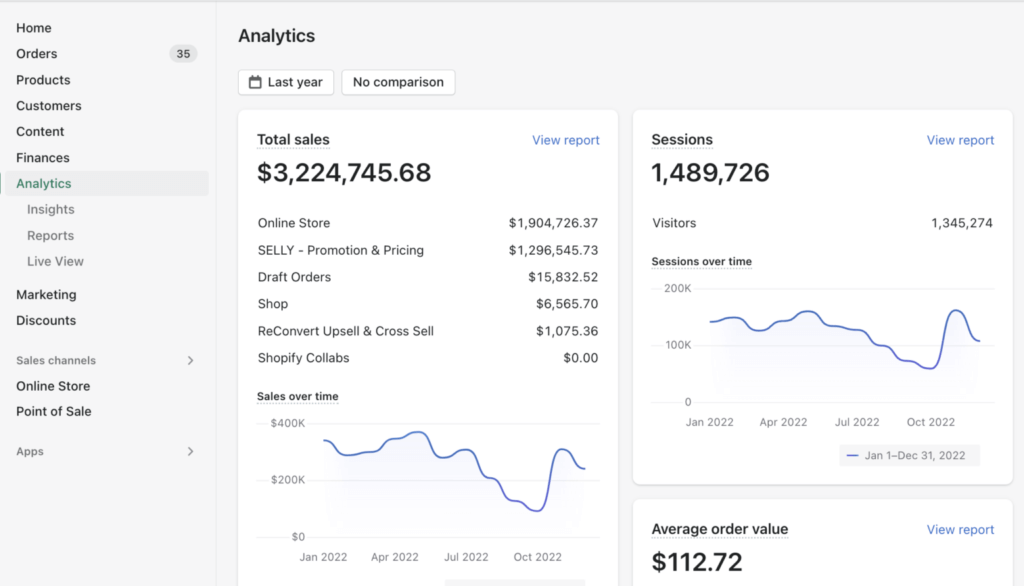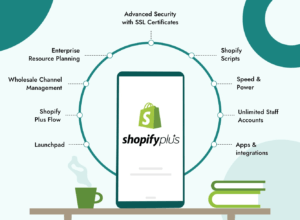Ecommerce has been rapidly evolving, especially in the last couple of years. The growth of e-commerce has accelerated due to the pandemic, and it shows no signs of slowing down in 2023. With more and more businesses entering the e-commerce arena, it’s essential to have a solid e-commerce growth strategy to ensure success.
In this article, we’ll cover 10 effective ways to grow your e-commerce store in 2023.
1: Optimize Your Website for Mobile Devices
With the rise of mobile usage, it’s essential to optimize your website for mobile devices. This means designing your website to be mobile-friendly, with a responsive design that adapts to different screen sizes.
- Use a responsive design: A responsive design will automatically adjust your website’s layout to fit the size of the user’s screen, whether they are using a desktop, tablet, or smartphone.
- Simplify your design: Keep your design simple and clutter-free. Avoid using too many images or videos that can slow down your website’s load time.
- Make sure your font is legible: Use a font that is easy to read on a small screen. Avoid small fonts or fancy fonts that can be difficult to read.
- Optimize your images: Optimize your images for the web by reducing their size and compressing them without sacrificing quality.
- Test your website on mobile devices: Use tools like Google’s Mobile-Friendly Test to check if your website is mobile-friendly.
By optimizing your website for mobile devices, you can improve your website’s user experience and increase your chances of converting mobile visitors into customers.
2: Improve Site Speed and Performance
In today’s fast-paced digital world, online shoppers expect websites to load quickly and perform flawlessly. If your e-commerce store has slow loading times and sluggish performance, it can result in a high bounce rate, low conversion rate, and ultimately, lost revenue.
- Optimize your images: Large images can significantly slow down your website’s loading speed. Compress and optimize images to ensure they’re the smallest file size possible without sacrificing quality.
- Minimize HTTP requests: Every time a user loads a page, the browser makes an HTTP request to the server. Minimize the number of requests by simplifying your website design and removing unnecessary elements.
- Use a content delivery network (CDN): A CDN can speed up your website by caching content in multiple locations worldwide, so users can access it faster.
- Enable caching: Caching enables the website to store data locally, reducing the need to reload data every time a user visits the site.
- Minimize code and use compressed files: Minimize your website’s code and use compressed files, which can reduce the time it takes to load the site.
- Choose a fast hosting provider: Choose a reliable and fast hosting provider to ensure your website loads quickly for users.
By implementing these strategies, you can significantly improve your website’s speed and performance, leading to a better user experience and increased conversion rate.
3. Utilizing Email Automation
Email automation is a powerful tool that can help you increase customer engagement, drive more sales, and improve your overall e-commerce growth. With the right email marketing strategy in place, you can connect with your customers in a more personalized and meaningful way. And if you need help with your email marketing, Mapplinks provides email marketing services that can help you create effective email campaigns.
- Welcome series: Set up a series of automated emails to welcome new subscribers to your email list and introduce them to your brand.
- Abandoned cart emails: If a customer leaves items in their cart without completing their purchase, send them a series of automated reminder emails to encourage them to come back and complete their order.
- Post-purchase follow-up: Send automated emails to customers after they make a purchase, thanking them for their order and asking for feedback.
- Product recommendations: Use customer data to send personalized product recommendations via email.
- Re-engagement campaigns: If a customer hasn’t interacted with your brand in a while, set up an automated campaign to try to re-engage them.
- Birthday/anniversary emails: Send automated emails to customers on their birthday or anniversary with a special offer or discount.
By utilizing email automation, you can save time and increase the effectiveness of your email marketing efforts .
At Mapplinks, we provide email marketing services that can help you create effective email campaigns. Here’s a case study on how we generated $1M+ In Revenue For An E-commerce Client Using Integrated Email And SMS Marketing.

If you’re interested in learning more about our email marketing services. Feel free to book a consultation with us.
4. Leverage social media
Social media is a powerful tool for e-commerce businesses, allowing you to reach a wider audience and engage with customers in a more personal way.
- Choose the right social media platforms: Depending on your target audience and products, select the most effective social media platforms to use. Some popular platforms include Facebook, Instagram, Twitter, Pinterest, LinkedIn, and TikTok.
- Optimize your social media profiles: Ensure that your profiles have a professional and consistent look and feel. Use relevant keywords in your profiles and make sure to include links to your e-commerce store.
- Create engaging content: Develop content that resonates with your target audience and aligns with your brand values. Use high-quality images, videos, and infographics to showcase your products and services. Experiment with different content formats to determine what works best.
- Utilize influencer marketing: Partner with influencers to promote your products and services to their followers. Collaborate with influencers who have a significant following and align with your brand values.
- Engage with your followers: Respond promptly to comments and messages and maintain a consistent presence on social media. Encourage user-generated content and reviews to build social proof and increase engagement.
- Leverage social media advertising: Use paid social media advertising to reach a wider audience and drive traffic to your e-commerce store. Experiment with different ad formats and targeting options to maximize your ROI.
- Monitor your social media metrics: Regularly track your social media analytics to evaluate your performance and adjust your strategy accordingly. Look for trends in engagement, reach, and conversions to identify areas for improvement.
Overall, social media can be a powerful tool for e-commerce growth. By building a strong social media presence and leveraging the right strategies, you can increase brand awareness, drive traffic, and boost sales.
5. Implement Upselling and Cross-selling Techniques
Upselling and cross-selling techniques are effective ways to increase your average order value and boost revenue. You can use upselling to encourage customers to upgrade to a higher-priced product or add premium features to their purchase, while cross-selling involves suggesting complementary products that can be purchased alongside the initial item.
- Identify the right products to upsell and cross-sell: Look for products that complement the ones that customers are already buying. For example, if a customer is purchasing a laptop, suggest a laptop bag or a wireless mouse.
- Use product bundles: Offer discounts on bundles of complementary products to encourage customers to buy more.
- Display related products: Show related products on product pages to give customers more options and ideas.
- Offer personalized recommendations: Use data on customers’ previous purchases and browsing behavior to recommend products that they might be interested in.
- Make the recommendations prominent: Feature the upsell and cross-sell options prominently on product pages and during the checkout process.
- Provide incentives: Offer discounts, free shipping, or other incentives to encourage customers to buy more.
- Test and measure: Continuously test and measure the effectiveness of your upselling and cross-selling strategies to see what works best for your e-commerce store.
By analyzing your sales data, understanding your customers, and providing personalized recommendations, you can create a shopping experience that delights your customers and keeps them coming back for more. So start experimenting with upselling and cross-selling today and see how it can help your e-commerce store grow in 2023.
6. Improve your website’s SEO
Search engine optimization (SEO) is essential for driving organic traffic to your e-commerce store. By optimizing your website’s content, keywords, and metadata, you can improve your search engine rankings and increase your visibility to potential customers. This includes using relevant keywords in your product descriptions, optimizing your images and videos, and creating high-quality content that’s shareable and linkable.
- Conduct keyword research: Research the keywords that your target audience is using to find products similar to yours. Use keyword research tools such as Google Keyword Planner or SEMrush to find the right keywords to optimize your website for.
- Optimize website structure: Ensure that your website’s structure is clear and easy to navigate. Use clear and descriptive URLs, organize your content into categories and subcategories, and make sure your website’s pages are interlinked.
- Create quality content: Creating quality, original content that is relevant to your target audience is crucial for improving your website’s SEO. Ensure that your content is informative, engaging, and incorporates relevant keywords.
- Optimize on-page elements: Optimize on-page elements such as meta titles, descriptions, headings, and images to make them relevant to your target keywords.
- Build high-quality backlinks: Building high-quality backlinks to your website from other authoritative websites can help improve your website’s visibility on search engines.
- Use social media to drive traffic: Share your content on social media platforms to drive traffic to your website. This can help increase engagement, shares, and ultimately improve your website’s SEO.
- Monitor and analyze your SEO performance: Use tools such as Google Analytics to monitor and analyze your website’s SEO performance. Use this data to make informed decisions about future SEO strategies.
Remember, improving your website’s SEO takes time and effort, but it can pay off in the long run by driving more traffic and increasing sales for your e-commerce store.
7. Personalize the customer experience
Personalization is a key trend in e-commerce, with customers increasingly expecting personalized recommendations and offers based on their browsing and purchase history. By using data and analytics to create personalized product recommendations, you can improve the customer experience and encourage repeat purchases.
- Collect data: Start by collecting as much data about your customers as possible. This could include their purchase history, browsing behavior, demographic information, and more. The more data you have, the better you’ll be able to personalize their experience.
- Tailor product recommendations: Use the data you’ve collected to offer personalized product recommendations. This could be based on items they’ve previously purchased or products that are frequently bought together.
- Send personalized emails: Use email marketing to send personalized messages to your customers. This could include emails based on their purchase history, abandoned cart reminders, and more.
- Implement a loyalty program: Reward your loyal customers with a loyalty program that offers exclusive discounts and perks. Use data to personalize the program based on their preferences and behaviors.
- Personalize the checkout process: Use the data you’ve collected to personalize the checkout process. This could include offering suggested shipping options, payment methods, and more.
- Offer personalized support: Use data to personalize your customer support. This could include offering product recommendations, addressing issues they’ve previously had, and more.
Personalizing the customer experience is key to growing your e-commerce store in 2023. By understanding your audience, tailoring your messaging, and using the right tools and technology, you can provide a memorable shopping experience that keeps customers coming back for more. By implementing these strategies and consistently monitoring and improving your approach, you can build a loyal customer base and increase revenue over time. So take the time to invest in personalization, and watch your e-commerce business thrive.
ALSO SEE: Welcome Email Series Examples And Tips For Ecommerce
8. Offer free shipping and returns
In the highly competitive world of e-commerce, providing free shipping and hassle-free returns has become a crucial factor in winning over customers and driving sales. By offering free shipping and returns, you can not only attract new customers but also build customer loyalty and increase repeat purchases. Here are some ways to implement free shipping and returns in your e-commerce store:
- Set a minimum order threshold for free shipping: By setting a minimum order value for free shipping, you can encourage customers to add more items to their cart and increase their average order value.
- Use free shipping as a promotional tool: Consider offering free shipping as a limited-time promotion to entice customers to make a purchase. You can also tie it to specific holidays or events to make it more appealing.
- Negotiate shipping rates with carriers: Work with shipping carriers to negotiate lower rates based on your shipping volume. This can help you offer free or discounted shipping without cutting into your profits.
- Implement a hassle-free return policy: Make it easy for customers to return items by providing a prepaid shipping label and clear instructions. This will help build customer trust and satisfaction.
- Optimize your shipping and returns process: Streamline your shipping and returns process to make it as efficient as possible. This will help you save time and money while providing a better customer experience.
By offering free shipping and hassle-free returns, you can create a positive customer experience that sets your e-commerce store apart from the competition. With these tips, you can implement a successful free shipping and returns strategy to boost sales and customer loyalty.
9. Improve your website’s conversion rate
In today’s competitive E-commerce landscape, improving your website’s conversion rate is a critical factor in driving sales and growing your online business. By optimizing your site to provide a seamless and enjoyable user experience, you can increase the likelihood that visitors will become customers. Here are some tips to help improve your website’s conversion rate:
- Optimize your website’s design: Make sure your website is visually appealing, easy to navigate, and has clear calls-to-action. Use high-quality product images and compelling copy to showcase your products and entice visitors to make a purchase.
- Streamline the checkout process: Make it easy for customers to complete their purchase by minimizing the number of steps required to checkout. Allow customers to save their information for future purchases and offer a variety of payment options.
- Provide social proof: Highlight customer reviews and ratings on your website to build trust with potential customers. Consider offering incentives for customers to leave reviews, such as a discount on their next purchase.
- Utilize retargeting: Use retargeting ads to remind customers of products they viewed but did not purchase. This can help bring customers back to your website and increase the likelihood of a sale.
- Improve site speed and performance: A slow website can deter potential customers from making a purchase. Make sure your website loads quickly and is optimized for mobile devices.
By implementing these tips and continually testing and optimizing your website, you can improve your website’s conversion rate and drive sales growth for your E-commerce store.
10. Monitor and analyze your e-commerce metrics
Finally, it’s important to regularly monitor and analyze your e-commerce metrics to identify areas for improvement and optimize your strategies for growth. This includes tracking your website’s traffic and conversion rates, analyzing your customer data and behavior, and using analytics tools to measure the ROI of your marketing campaigns.
- Track website traffic and visitor behavior: Use tools such as Google Analytics to monitor website traffic and visitor behavior. This data will help you understand which pages are popular, how long visitors are staying on your site, and where they are coming from.
- Monitor conversion rates: Keep a close eye on your conversion rates and track changes over time. This will help you identify which products or pages are driving the most sales and which need improvement.
- Analyze customer feedback: Listen to what your customers are saying about your products, website, and service. Use feedback tools or surveys to gather insights and address any pain points.
- Keep an eye on inventory: Stay on top of your inventory levels to ensure you have enough stock to fulfill orders. Use inventory management software to automate this process and avoid stockouts.
- Monitor shipping and delivery times: Make sure your shipping and delivery times are meeting customer expectations. Monitor shipping carriers and address any delays or issues promptly.
- Review marketing campaigns: Analyze the performance of your marketing campaigns to determine what is working and what isn’t. Use this information to optimize your campaigns and drive more traffic and sales.
- Monitor customer lifetime value (CLV): Keep track of your customers’ lifetime value to understand how much revenue they are generating over time. Use this information to personalize your marketing and improve customer retention.
- Analyze website performance: Use website performance tools to monitor your website’s loading speed, page errors, and other technical metrics. Address any issues promptly to improve user experience and SEO.
- Monitor social media metrics: Keep track of your social media metrics, such as engagement rates and follower growth, to understand which channels are driving the most traffic and sales.
- Monitor competition: Keep an eye on your competitors’ performance, pricing, and promotions. Use this information to make strategic decisions and stay ahead of the game.
By monitoring and analyzing your e-commerce metrics, you can make data-driven decisions that will help you optimize your store’s performance, increase sales, and ultimately grow your e-commerce business.
Developing a solid e-commerce growth strategy is crucial for any business that aims to succeed in the online marketplace in 2023 and beyond. By implementing the ten tips discussed in this article, you can improve your website’s performance, drive traffic, increase conversion rates, and boost customer loyalty.
Remember to regularly monitor and analyze your e-commerce metrics, keep up with the latest industry trends, and adjust your strategy as needed. With dedication, hard work, and a customer-focused approach, your e-commerce store can achieve sustainable growth and long-term success.



